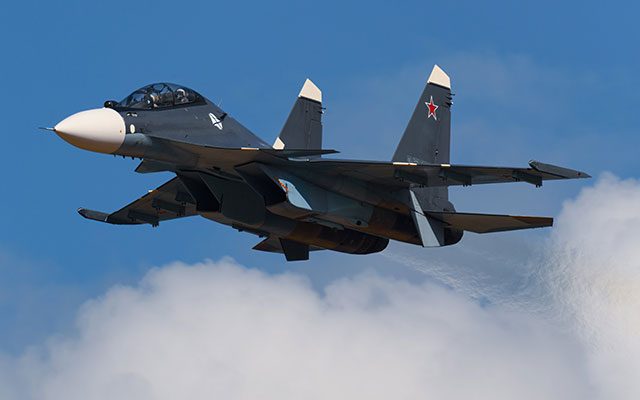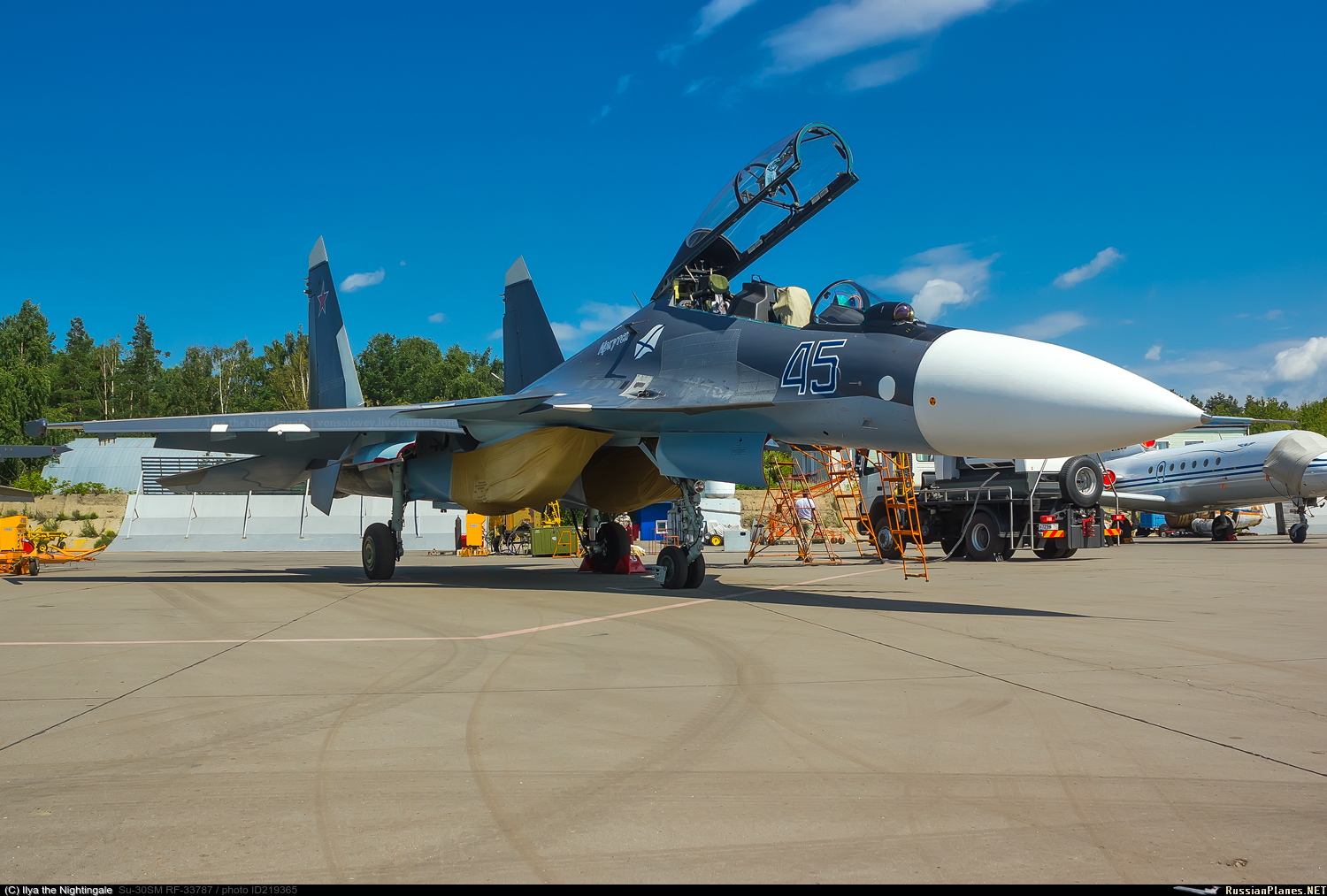- Joined
- Nov 9, 2021
- Messages
- 5,106
- Likes
- 12,244
Russia gets new Su-30 – 16% more thrust, new
radar, UAV control

MOSCOW, ($1=77.59 Russian Rubles) – Russian aviation has begun arming itself with a new modification of its twin-engine, two-seat supermaneuverable fighter aircraft Su-30, BulgarianMilitary.com has learned, citing a statement on the official Twitter account of the state-owned United Aircraft Corporation [UAC].
Russia unveiled a better S-70 UCAV with stealth nozzle configuration
Russia expects new Su-35s, Su-57s, helos, and Kinzhal missiles in 2022
China and Russia drew a new military road map until 2025
It is clear from the press release that the corporation has already delivered the first four Su-30SM2 fighters. The planes were built last year. In 2022, the United Aircraft Corporation continues to produce the SM2 series, which in fact over time should replace the existing SM.
The Su-30SM2 has 16% more thrust thanks to a newly installed Izdelie 117S engine, which replaces the previously used Al-31FP. Currently, Russian Su-30s operate with N011M-R Bars-R radar. However, the new version gets a multi-mode, hybrid passive electronically scanned array [PESA] N035 Irbis-E.
The characteristic of PESA radars is that during missions the information that is returned to the aircraft in the form of radio electromagnetic waves is distributed at one point on the radar. This is somewhat of a problem, as it can lead to overheating of the radar installation and possible problems with its operation. AESA, which is the other type of radar device and is very common among Western manufacturers, does not have this problem. With it, the returned radio electromagnetic waves are distributed over the entire surface of the radar grid, which helps to speed up data processing and prevent overheating of systems.
Electronic warfare and counter-warfare systems have also been replaced. For this purpose, the Russians have installed in the Su-30SM2 an updated version of the existing integrated electronic guidance kit. Ie the old version OLS-30 IRST has been replaced with its updated version OLS-35 IRST.
The Su-30SM2 has an integrated OSNOD system, which in addition to control and data sharing is also designed to control unmanned aerial vehicles in their role as an additional attacking wing. The current electronic system for the pilot’s helmet, which was Ukrainian-made, has already been replaced by a Russian-made one. The plant has also replaced Thales’ French display systems [Thales SMD55S / 66S] with Russian ones, but the company did not name their model or manufacturer.
The subsidiary of the Russian state company Rostec, Crete, has provided a brand new development of the strap-down inertial navigation system – BINS-SP2. The system consists of three laser gyroscopes and three quartz accelerometers. BINS-SP2 can determine platform coordinates and motion variables in the absence of external input data. In short – this means that the Su-30SM2 can fly in the absence of satellite, ground, or offshore navigation systems. The system can operate at altitudes up to 25 km and over a wide temperature range: from -60 degrees Celsius to +60 degrees Celsius.
United Aircraft Corporation says that the Su-30SM2 has a change in armament, as the company claims that the armament of the Su-30SM2 is equivalent to that of the Su-35 Flanker E, and further added the ability to install and operate the Kh-32 cruise missile. I.e. According to the Russian company, the Su-30SM2 has a set of bombs, cruise missiles, 1 × 30-mm automatic cannon Grjasew-Schipunow GSch-301 [9A-4071K] with up to 150 rounds of ammunition, guided bombs, air-to-air missiles, air-to-surface missiles, etc.

 bulgarianmilitary.com
bulgarianmilitary.com
radar, UAV control
MOSCOW, ($1=77.59 Russian Rubles) – Russian aviation has begun arming itself with a new modification of its twin-engine, two-seat supermaneuverable fighter aircraft Su-30, BulgarianMilitary.com has learned, citing a statement on the official Twitter account of the state-owned United Aircraft Corporation [UAC].
Russia unveiled a better S-70 UCAV with stealth nozzle configuration
Russia expects new Su-35s, Su-57s, helos, and Kinzhal missiles in 2022
China and Russia drew a new military road map until 2025
It is clear from the press release that the corporation has already delivered the first four Su-30SM2 fighters. The planes were built last year. In 2022, the United Aircraft Corporation continues to produce the SM2 series, which in fact over time should replace the existing SM.
The Su-30SM2 has 16% more thrust thanks to a newly installed Izdelie 117S engine, which replaces the previously used Al-31FP. Currently, Russian Su-30s operate with N011M-R Bars-R radar. However, the new version gets a multi-mode, hybrid passive electronically scanned array [PESA] N035 Irbis-E.
The characteristic of PESA radars is that during missions the information that is returned to the aircraft in the form of radio electromagnetic waves is distributed at one point on the radar. This is somewhat of a problem, as it can lead to overheating of the radar installation and possible problems with its operation. AESA, which is the other type of radar device and is very common among Western manufacturers, does not have this problem. With it, the returned radio electromagnetic waves are distributed over the entire surface of the radar grid, which helps to speed up data processing and prevent overheating of systems.
Electronic warfare and counter-warfare systems have also been replaced. For this purpose, the Russians have installed in the Su-30SM2 an updated version of the existing integrated electronic guidance kit. Ie the old version OLS-30 IRST has been replaced with its updated version OLS-35 IRST.
The Su-30SM2 has an integrated OSNOD system, which in addition to control and data sharing is also designed to control unmanned aerial vehicles in their role as an additional attacking wing. The current electronic system for the pilot’s helmet, which was Ukrainian-made, has already been replaced by a Russian-made one. The plant has also replaced Thales’ French display systems [Thales SMD55S / 66S] with Russian ones, but the company did not name their model or manufacturer.
The subsidiary of the Russian state company Rostec, Crete, has provided a brand new development of the strap-down inertial navigation system – BINS-SP2. The system consists of three laser gyroscopes and three quartz accelerometers. BINS-SP2 can determine platform coordinates and motion variables in the absence of external input data. In short – this means that the Su-30SM2 can fly in the absence of satellite, ground, or offshore navigation systems. The system can operate at altitudes up to 25 km and over a wide temperature range: from -60 degrees Celsius to +60 degrees Celsius.
United Aircraft Corporation says that the Su-30SM2 has a change in armament, as the company claims that the armament of the Su-30SM2 is equivalent to that of the Su-35 Flanker E, and further added the ability to install and operate the Kh-32 cruise missile. I.e. According to the Russian company, the Su-30SM2 has a set of bombs, cruise missiles, 1 × 30-mm automatic cannon Grjasew-Schipunow GSch-301 [9A-4071K] with up to 150 rounds of ammunition, guided bombs, air-to-air missiles, air-to-surface missiles, etc.

Russia gets new Su-30 - 16% more thrust, new radar, UAV control
Russian aviation has begun arming itself with a new modification of its twin-engine, two-seat supermaneuverable fighter aircraft Su-30, UAC said in a statement.

